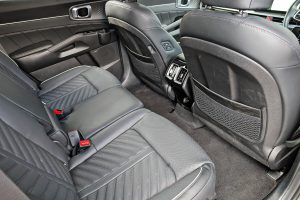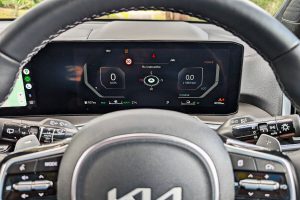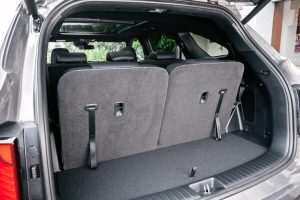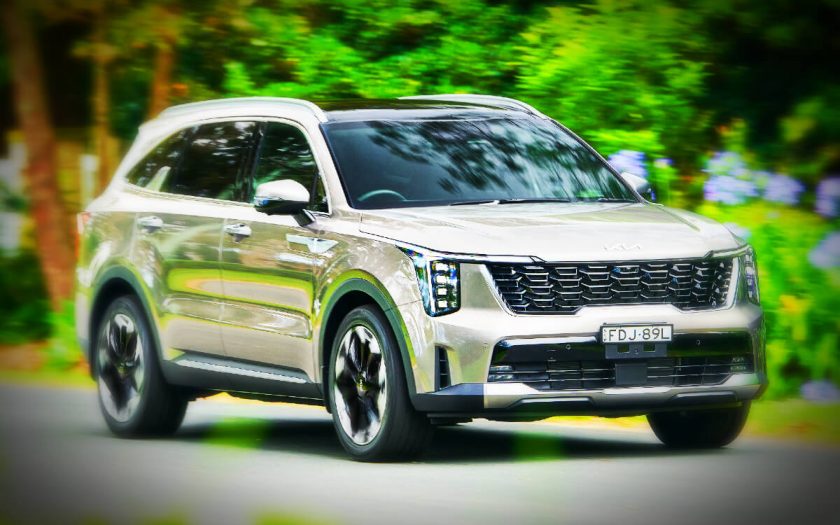Chris Riley tests the 2025 Kia Sorento PHEV GT-Line large seven-seater all-wheel drive SUV with pricing, specs, ride and handling, safety, verdict and everything the over-50 driver needs to know.
Summary: The PHEV system in the Sorento is not as sophisticated as some others, and for the time being, you can only get the PHEV in the flagship GT-Line model.
2025 Kia Sorento PHEV GT-Line all-wheel drive large SUV
Pricing: $84,660 (plus on road costs)
Warranty: Seven-years, unlimited kilometre, seven-years capped price servicing, up to eight years roadside assist. Seven-years battery pack warranty
Safety: Five-star ANCAP (2020)
Engine: 1.6-litre turbocharged four-cylinder petrol hybrid engine
Battery: 14kWh lithium-ion
Service intervals: 12 months or 10,000km
Power: 132kW @ 5500rpm (ICE), 67kW (e-motor), 195kW combined
Torque: 265Nm @ 1500-4500rpm (ICE), 304Nm (e-motor), 350Nm combined
Transmission: six-speed Spors-Matic auto, on-demand all-wheel drive
Body: 4180mm (long); 1900mm (wide); 1695mm (high)
Build country: South Korea
Kerb weight: 2052kg
Towing capacity: 1350kg
Luggage storage: 187L (all rows upright), 616L (rear row stowed), 2011L (both rear rows stowed)
Wheels: 19-inch alloy
Tyres: 235/55 R19
Spare wheel: full-size alloy
Turning circle: 11.6m
Fuel tank: 67 litres
Electric range: 68km (57km WLTP)
Time to charge: 3 hours 25 minutes
Claimed consumption: 1.6L/100km (95 RON unleaded)
Consumption on test: 6.8L/100km (470km)
seniordriveraus consumption on test: not tested

[review]
It’s becoming harder to tell internal combustion from electric vehicles, and even more difficult to identify the in-betweeners – the hybrids and plug-in hybrids that combine technologies.
The new Product Enhanced Sorento takes its styling cues from the fully-electric EV9 and sees changes to the exterior and interior design, comfort and convenience technology, with additional safety features thrown in.
New Sorento offers a range of drivetrains including hybrid and plug-in hybrid variants, both of which arrive in top-spec GT-Line guise only, adding to the price of the technology – or perhaps absorbing the cost.

What’s it cost?
There are three grades from which to choose, priced from $70,330 plus on-road costs.
Sorento GT-Line HEV FWD is $70,330, Sorento GT-Line HEV AWD is $73,330 and Sorento GT-Line PHEV AWD is $84,660.
Taking design cues from the EV9, the facelifted Sorento line-up boasts a restyled face, as well as a new-look lower bumper and revised LED taillights at the rear.
Inside, a larger 12.3-inch infotainment system with the latest ‘ccNC’ software brings wireless functionality to both Apple CarPlay and Android Auto.
The sweeping, ultra-wide display panel also houses a second 12.3-inch screen for the instrumentation, plus a smaller 5.0-inch screen for the aircon which separates them.
The latter replicates the physical buttons that sit under the screen and that can also be used to control the climate system – and more easily into the bargain.
GT-Line also offers a Digital Centre Mirror (DCM) which thank goodness lets users switch between a standard rear-view mirror and a camera display for maximum rear visibility without any heads or headrests blocking the view.
Other new additions include a revised shift-by-wire gear selector and new USB-C charging ports.
Kia Connect telematics has also been added, allowing improved remote car controls via smartphone.
However, the “enhancements” have largely been cosmetic, with no changes to the actual hybrid drivetrains which power the large, seven-seat wagon.

Standard equipment includes 19-inch alloys, quilted Nappa leather, two-zone climate air, rear air outlets and controls, heated steering wheel, power adjust front seats, with heating and cooling, plus heated outer second row seats, together with alloy sports pedals and door scuff strips and a power-operated panoramic sunroof.
There’s also head-up display, smart cruise control, passenger talk intercom, remote smart parking assist, auto lights and wipers, auto-dip on reverse mirrors, interior mood lighting, eight cupholders and four bottle holders, second row sunscreens, privacy glass (rear windows and tailgate) plus a hands-free power tailgate.
The 12.3-inch infotainment system supports AI voice commands with natural voice recognition, multi-connect Bluetooth, built-in satellite navigation, AM/FM and DAB+ digital radio, wireless and wired CarPlay and Android Auto plus Sounds of Nature background soundtracks.
Hybrid variants also get a premium Bose 12-speaker audio.
The system supports over-the-air updates and Kia Connect, including auto SOS in the event of an accident, vehicle status monitoring and you can even send an address directly from the app to the vehicle navigation system.
There are six USB-C outlets (2+2+2), two 12-volt outlets, plus wireless phone charging.
Kia Connect is complimentary for seven years.
Safety upgrades see the introduction of next generation Highway Driving Assist (HDA) which functions only when driving on motorways.
Essentially, it builds on adaptive cruise control with stop-and-go capability, combined with Lane Following Assist (LFA) to keep the car centred in the lane, even when driving around a bend in the road.
Parking Distance Warning (Front, Side, Rear) has been added on side detection zones to provide a more comprehensive warning system that will warn the driver when a collision is likely during parking.
Sorento offers four ISOFix and five top tether Child restraint anchor points.
A full-size alloy spare is provided.
Sorento is covered by the company’s seven-year unlimited kilometre warranty together with seven years of capped price servicing and roadside assistance.
Service is due every 12 months or 10,000km.

What’s it go like?
Sorento gets better with every outing.
GT-Line especially looks and feels like the premium product that it is and deserves a larger slice of the cake.
But it currently trails the Toyota Prado, Ford Everest and Isuzu MU-X in the sales race.
At a length of 4185mm and with a 2815mm wheelbase, Sorento can seat seven in relative comfort, but is still no replacement for a purpose-built people mover.
While the hybrid and plug-in hybrid versions of Sorento are based on the same 1.6-litre turbocharged four-cylinder engine, the electric assistance each receives is substantially different.
The combined output of the hybrid is 169kW of power and 350Nm of torque, while the plug-in with a more powerful electric motor delivers 195kW and 350Nm.
While both get the same six-speed ‘Sports-Matic’ transmission, the hybrid comes in front- and all-wheel drive, while the top-of-the-line plug-in is all-wheel drive only.
There are three drive modes – Eco, Sport and Smart mode.
The PHEV can perform as an electric vehicle, hybrid or internal combustion vehicle.
The idea is that you can drive it to work during the week using electricity alone, then on the weekend you can head up or down the coast confident that the fallback petrol engine will get you home.
On paper, at least, it’s got all the bases covered.
Fuel consumption is a claimed 5.4L/100km for the front-drive, 5.7L/100km for the all-wheel drive and 1.6L/100km for the plug-in all-wheel drive hybrid.
This compares with 6.0L/100km for the turbodiesel and 9.8L/100km for the 3.5-litre petrol V6 engines which are also offered.
However, to achieve 1.6L/100km the plug-in must be recharged every 100km, otherwise with no support from the electric motor it reverts to a petrol-only proposition, albeit with the extra weight of the dormant 140kg battery pack and electric motor to haul.
That’s just the way it is, and it is the same for all plug-in hybrids.
The plug-in’s all-electric range by the way is 68km (or 57km under the more realistic WLTP standard).
It’s a lot of mucking around for little gain and the extra purchase cost of the vehicle, isn’t it?
At least the plug-in doesn’t take as long to re-charge as a full-on EV.
The small 14kWh lithium-ion polymer battery pack is secreted under the second row of seats and can be charged via AC single-phase power.
That means your basic 10A powerpoint and it will take as little as three hours and 25 minutes to charge from 15 to 95 percent.
We clocked up 470km at a rate of 6.8L/100km.
Unfortunately, we didn’t get a chance to recharge the battery and to be frank, we reckon the majority of drivers will fall into this category, which negates the big outlay for the PHEV in the first place.
Anecdotally, we hear many lease vehicles are returned with the charge cable untouched.
The trip computer in our test vehicle showed a long-term average of 6.4L/100km and it takes premium 95 unleaded.
Questions of charging aside, the PHEV is likeable and easy to drive, if not entirely convincing when it comes to performance.
With an emphasis on fuel economy, it’s more a case of being adequate rather than responding strongly to the throttle in a straight line – for example, when overtaking.
If you’re okay with this read on, otherwise Kia still offers diesel and petrol-V6 alternatives that will deliver higher levels of performance.
The cabin is a nice place to spend time.
The steering is light, and it is easy to manoeuvre when it comes to parking.
The ride for the most part is pretty good and a reflection of Kia’s local tuning efforts, occasionally delivering a sharper than expected response depending on the surface you are travelling over.
Forget the digital rear vision mirror if you wear multi-focal glasses. It is almost impossible to bring into focus quickly and nauseating when you get there. Whoever thinks up these things needs a reality check.

What we like
- Big and comfortable
- Easy to drive
- Doesn’t use much fuel
What we don’t like
- Insignificant electric range
- Needs bigger battery
- Costs too much
What over-50s need to know
The Sorento PHEV will appeal to buyers who want to put a foot in the electric pool, but don’t want to go in for a swim.
The car might appeal, but the price won’t!
Other than that, the PHEV has all bases covered.
It’s big, it’s well equipped, a comfortable place in which to travel and doesn’t use much fuel.
If you’ve got the time and money to devote to the strict charging regime, then maybe it’s for you.
We’ll pass… at least on the PHEV.

seniordriver comments
Kia has come a long way since it was a cut-price brand. The interior feels much more upmarket and better than many of its rivals. Mind you, at this price point, so it should!
One oddity is that you can’t show a live-map navigation readout. It’s a niggling annoyance, and we can’t understand why it should be like this.
If the grandchildren are in the back seat, you’ll love the passenger talk function that gets through to them by way of the speakers and a microphone up front.
There are directional vents in the middle row, but no climate controls. The third row, like many of its kind, are best for emergency seating or small children. Headroom in the third row for full-sized people is quite tight and you’ll get to know your knees rather well.
We test drove the Hybrid Sorento GT-Line, not the PHEV. It’s an interesting comparison because we wonder how long it will take to recoup your costs if you choose the PHEV. It’s an extra $11,330 over the Hybrid ($14,330 if you also forego all-wheel drive) and that buys an awful lot of petrol. We managed 6.8L/100km in the Hybrid over 345km, which, coincidentally, is exactly the same consumption figure Chris achieved in the PHEV over 470km, and his figure is probably representative of the consumption most people will see (especially those who, like Chris, aren’t charging the car every 100km), rather than the optimistic 1.6L/100km official figure.
As we always say, whether you’ll be better off in an ICE vehicle, a hybrid or a BEV depends very much on your usage pattern.
